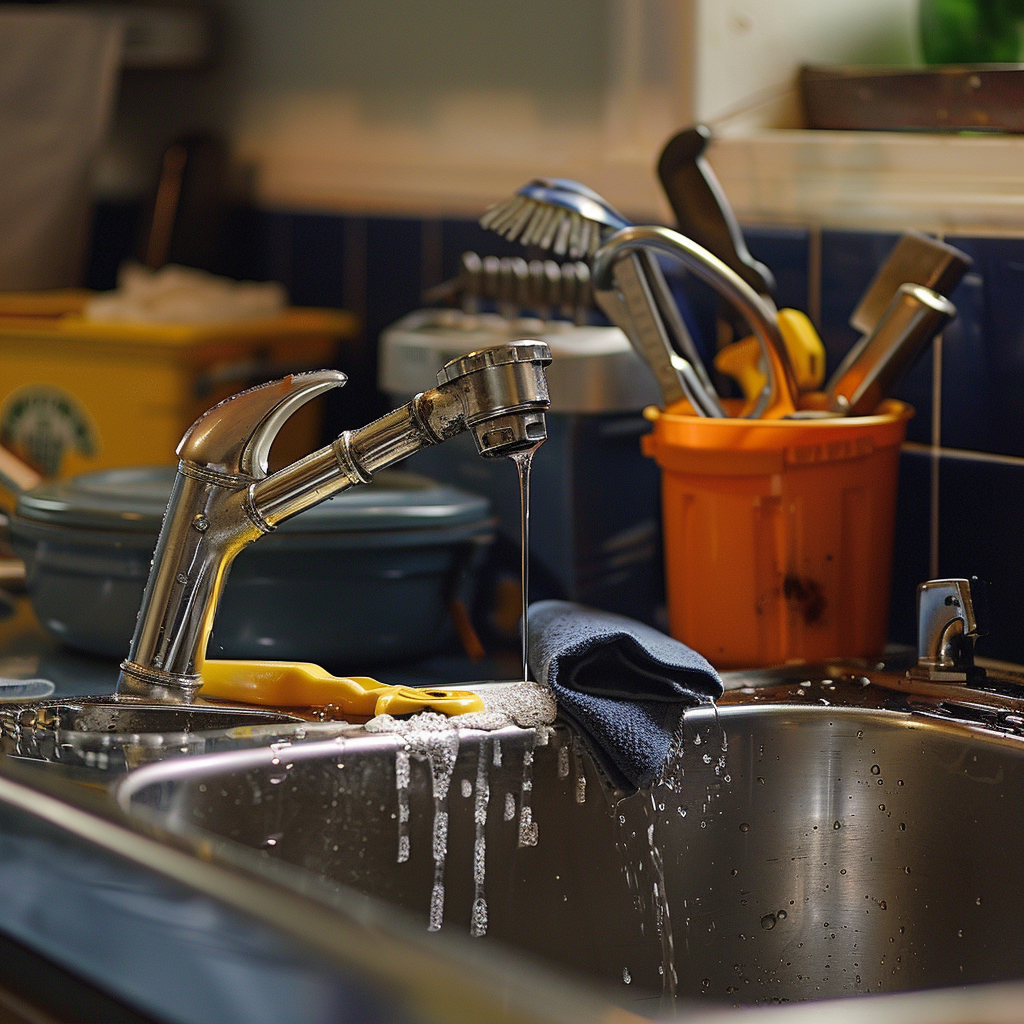Simple DIY Guide to Fixing a Dripping Tap and Preventing Water Waste

Share
How to Fix a Dripping Tap: Simple Solutions for Common Problems
A dripping tap can be more than just an annoyance; it can also waste a significant amount of water over time, leading to higher utility bills. Fortunately, fixing a dripping tap is a relatively simple DIY task that can save you money and reduce water waste. This guide will walk you through the process, from identifying the cause to implementing the solution.
Understanding Common Causes of a Dripping Tap
Before you start, it's essential to understand what might be causing the tap to drip. Common causes include:
- Worn-out Washer: The most common cause of a dripping tap. The washer presses against the valve seat, and over time, it can become worn, leading to leaks.
- Damaged Valve Seat: If the valve seat is corroded or damaged, it can cause the tap to drip.
- Worn O-ring: An O-ring is a small rubber ring that helps seal the tap. If it's worn or damaged, it can cause leaks.
- Faulty Cartridge: Modern taps often use a cartridge mechanism that can wear out or become damaged.
Tools and Supplies You’ll Need
Having the right tools and supplies on hand will make the process smoother. Here’s what you’ll need:
- Adjustable wrench
- Screwdriver (flat-head and Phillips)
- Replacement washer, O-ring, or cartridge (depending on the issue)
- Plumber’s grease
- Towel or rag
- Bucket
Step-by-Step Guide to Fixing a Dripping Tap
-
Turn Off the Water Supply
Before you start working on the tap, turn off the water supply to prevent any water from spilling. You can usually find the shut-off valve under the sink. -
Drain the Remaining Water
Open the tap to drain any remaining water in the pipes. This will make the repair process cleaner and easier. -
Remove the Tap Handle
Use a screwdriver to remove the screw holding the tap handle in place. The screw may be hidden under a decorative cap, which you can pry off with a flat-head screwdriver. -
Remove the Valve
Once the handle is removed, use an adjustable wrench to loosen and remove the valve. Be sure to place a towel or rag around the area to catch any drips. -
Inspect the Washer and O-ring
Check the washer and O-ring for any signs of wear or damage. If either is worn out, replace them with new ones. Apply a small amount of plumber’s grease to the new washer and O-ring before installing them. -
Check the Valve Seat
Inspect the valve seat for any signs of corrosion or damage. If the valve seat is damaged, you may need to replace it or use a valve seat grinder to smooth out any rough spots. -
Replace the Cartridge (if applicable)
If your tap uses a cartridge, check it for signs of wear or damage. Replace it with a new one if necessary. Be sure to follow the manufacturer's instructions for installing the new cartridge. -
Reassemble the Tap
Once you’ve replaced the necessary parts, reassemble the tap by reversing the steps you took to disassemble it. Tighten the valve with the adjustable wrench, then reattach the handle with the screw. -
Turn On the Water Supply
Turn the water supply back on and test the tap to ensure it’s no longer dripping. Check for any leaks around the handle or base of the tap.
Preventative Measures
Preventing a dripping tap in the future involves regular maintenance and mindful usage:
- Regular Inspections: Periodically check your taps for signs of wear and tear.
- Gentle Use: Avoid turning taps off too tightly, which can wear out the washer and O-ring more quickly.
- Quality Parts: Use high-quality replacement parts to ensure a longer-lasting fix.
When to Call a Professional
While fixing a dripping tap is typically a straightforward DIY task, there are times when you might need to call a professional plumber:
- Persistent Leaks: If the tap continues to drip after you’ve replaced the washer, O-ring, or cartridge, there may be a deeper issue that requires professional attention.
- Multiple Dripping Taps: If several taps in your home are dripping, it could indicate a larger plumbing problem.
- Corroded or Damaged Parts: If the valve seat or other components are heavily corroded or damaged, a professional may need to replace them.
Environmental and Financial Benefits
Fixing a dripping tap not only saves you money on your water bill but also has significant environmental benefits. A single dripping tap can waste up to 20 gallons of water per day, which adds up to over 7,000 gallons per year. By addressing the issue promptly, you can contribute to water conservation efforts and reduce your carbon footprint.
Tips for Prolonging the Life of Your Taps
- Regular Cleaning: Keep your taps clean and free of limescale buildup by wiping them down with a vinegar solution. This simple practice helps maintain the functionality and appearance of your taps.
- Gentle Handling: Avoid using excessive force when turning taps on and off. This helps prevent wear and tear on washers and O-rings, prolonging the life of your tap components.
- Use Tap Aerators: Install tap aerators to reduce water pressure and minimize the stress on internal components. Aerators mix air with water to create a smooth, splash-free flow, reducing wear and tear.
- Inspect Regularly: Periodically check your taps for signs of leaks or corrosion and address any issues promptly. Early detection can prevent minor problems from becoming major repairs.
DIY Drain Maintenance Tips
In addition to fixing a dripping tap, maintaining clear and efficient drains is crucial for a well-functioning plumbing system. Here are some additional tips for keeping your drains in top condition:
-
Use Boiling Water Regularly
Pouring a kettle of boiling water down your drains once a week can help prevent buildup and keep your pipes clear. -
Avoid Grease Disposal in Sinks
Never pour grease down the kitchen sink. Instead, let it solidify and dispose of it in the trash. Grease can solidify in your pipes, causing clogs and blockages. -
Install Drain Screens
Use drain screens in your kitchen and bathroom sinks to catch food particles, hair, and other debris. These inexpensive devices can prevent a lot of common drain problems. -
Monthly Baking Soda and Vinegar Treatment
Once a month, pour 1/2 cup of baking soda followed by 1/2 cup of vinegar down your drains. Let it fizz for a few minutes, then flush with boiling water. This natural method helps to break down organic material and keep your drains fresh. -
Use Enzyme Cleaners
Enzyme drain cleaners are an excellent natural alternative to harsh chemical cleaners. They use natural enzymes to break down organic matter in your pipes. Regular use can help prevent clogs and maintain clear drains. -
Be Mindful of What Goes Down the Drain
Avoid flushing non-degradable items like wipes, cotton balls, and dental floss down the toilet. These items can cause severe blockages in your plumbing system. -
Regularly Clean P-traps
The P-trap is the curved section of pipe under your sinks designed to catch debris and prevent sewer gases from entering your home. Regularly cleaning the P-trap can prevent clogs and keep your drains smelling fresh. -
Use a Plunger for Minor Clogs
A plunger can be a quick and effective tool for clearing minor clogs. Ensure you have a good seal around the drain and plunge vigorously to dislodge the blockage. -
Avoid Chemical Drain Cleaners
Chemical drain cleaners can be harsh on your pipes and the environment. Opt for natural or enzyme-based cleaners instead. -
Know When to Call a Professional
If you encounter persistent clogs or slow drains that DIY methods can’t fix, it may be time to call a professional plumber. Professional plumbers have the tools and expertise to diagnose and fix more severe plumbing issues.
Fixing a dripping tap is a simple, cost-effective way to save water and money. By following this step-by-step guide, you can tackle the problem yourself and enjoy a drip-free tap in no time. Regular maintenance and mindful usage can help prevent future leaks, ensuring your plumbing system remains in top condition. If you encounter persistent issues, don’t hesitate to call a professional plumber for assistance.
Maintaining your drains is equally important. By incorporating these DIY drain maintenance tips, you can keep your plumbing system running smoothly and avoid costly repairs. Natural and non-toxic methods not only protect your pipes but also contribute to a healthier home environment. Happy plumbing!


